2000 NISSAN PATROL ESP
[x] Cancel search: ESPPage 2 of 1033

FOREWORD
This manual contains maintenance and repair procedures for NISSAN
PATROL GR,modelY61 series.
In order to assure your safety and the efficient functioning of the vehicle,
this manual should be read thoroughly. It is especially important that the
PRECAUTIONS in the GI section be completely understood before starting
any repair task.
All information in this manual is based on the latest product information
at the time of publication. The right is reserved to make changes in speci-
®cations and methods at any time without notice.
IMPORTANT SAFETY NOTICE
The proper performance of service is essential for both the safety of the
technician and the efficient functioning of the vehicle.
The service methods in this Service Manual are described in such a man-
ner that the service may be performed safely and accurately.
Service varies with the procedures used, the skills of the technician and the
tools and parts available. Accordingly, anyone using service procedures,
tools or parts which are not speci®cally recommended by NISSAN must
®rst completely satisfy himself that neither his safety nor the vehicle's
safety will be jeopardized by the service method selected.
NISSAN EUROPE S.A.S.
Service Engineering SectionParis, France
Page 29 of 1033
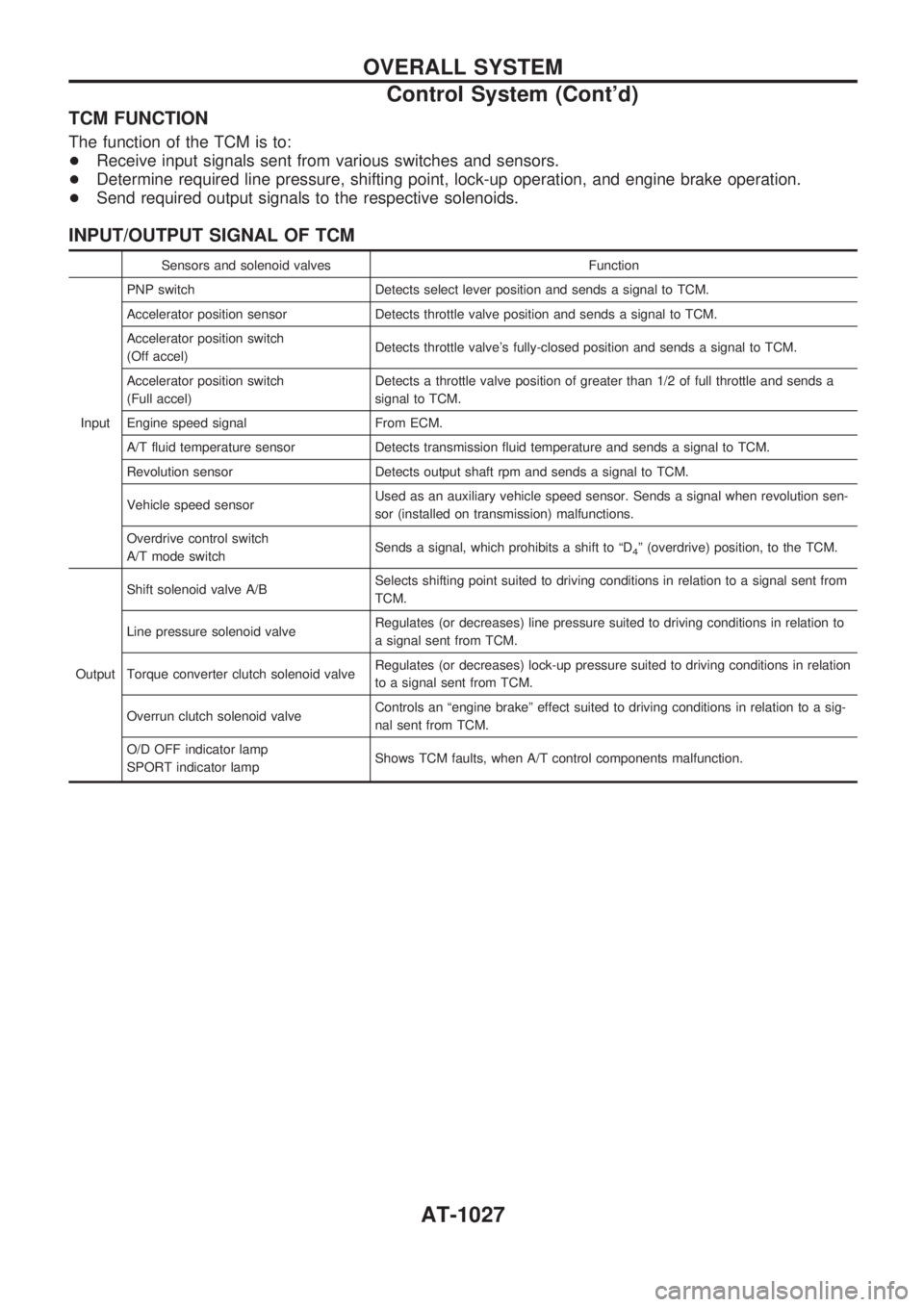
TCM FUNCTION
The function of the TCM is to:
+Receive input signals sent from various switches and sensors.
+Determine required line pressure, shifting point, lock-up operation, and engine brake operation.
+Send required output signals to the respective solenoids.
INPUT/OUTPUT SIGNAL OF TCM
Sensors and solenoid valves Function
InputPNP switch Detects select lever position and sends a signal to TCM.
Accelerator position sensor Detects throttle valve position and sends a signal to TCM.
Accelerator position switch
(Off accel)Detects throttle valve's fully-closed position and sends a signal to TCM.
Accelerator position switch
(Full accel)Detects a throttle valve position of greater than 1/2 of full throttle and sends a
signal to TCM.
Engine speed signal From ECM.
A/T fluid temperature sensor Detects transmission fluid temperature and sends a signal to TCM.
Revolution sensor Detects output shaft rpm and sends a signal to TCM.
Vehicle speed sensorUsed as an auxiliary vehicle speed sensor. Sends a signal when revolution sen-
sor (installed on transmission) malfunctions.
Overdrive control switch
A/T mode switchSends a signal, which prohibits a shift to ªD
4º (overdrive) position, to the TCM.
OutputShift solenoid valve A/BSelects shifting point suited to driving conditions in relation to a signal sent from
TCM.
Line pressure solenoid valveRegulates (or decreases) line pressure suited to driving conditions in relation to
a signal sent from TCM.
Torque converter clutch solenoid valveRegulates (or decreases) lock-up pressure suited to driving conditions in relation
to a signal sent from TCM.
Overrun clutch solenoid valveControls an ªengine brakeº effect suited to driving conditions in relation to a sig-
nal sent from TCM.
O/D OFF indicator lamp
SPORT indicator lampShows TCM faults, when A/T control components malfunction.
OVERALL SYSTEM
Control System (Cont'd)
AT-1027
Page 38 of 1033
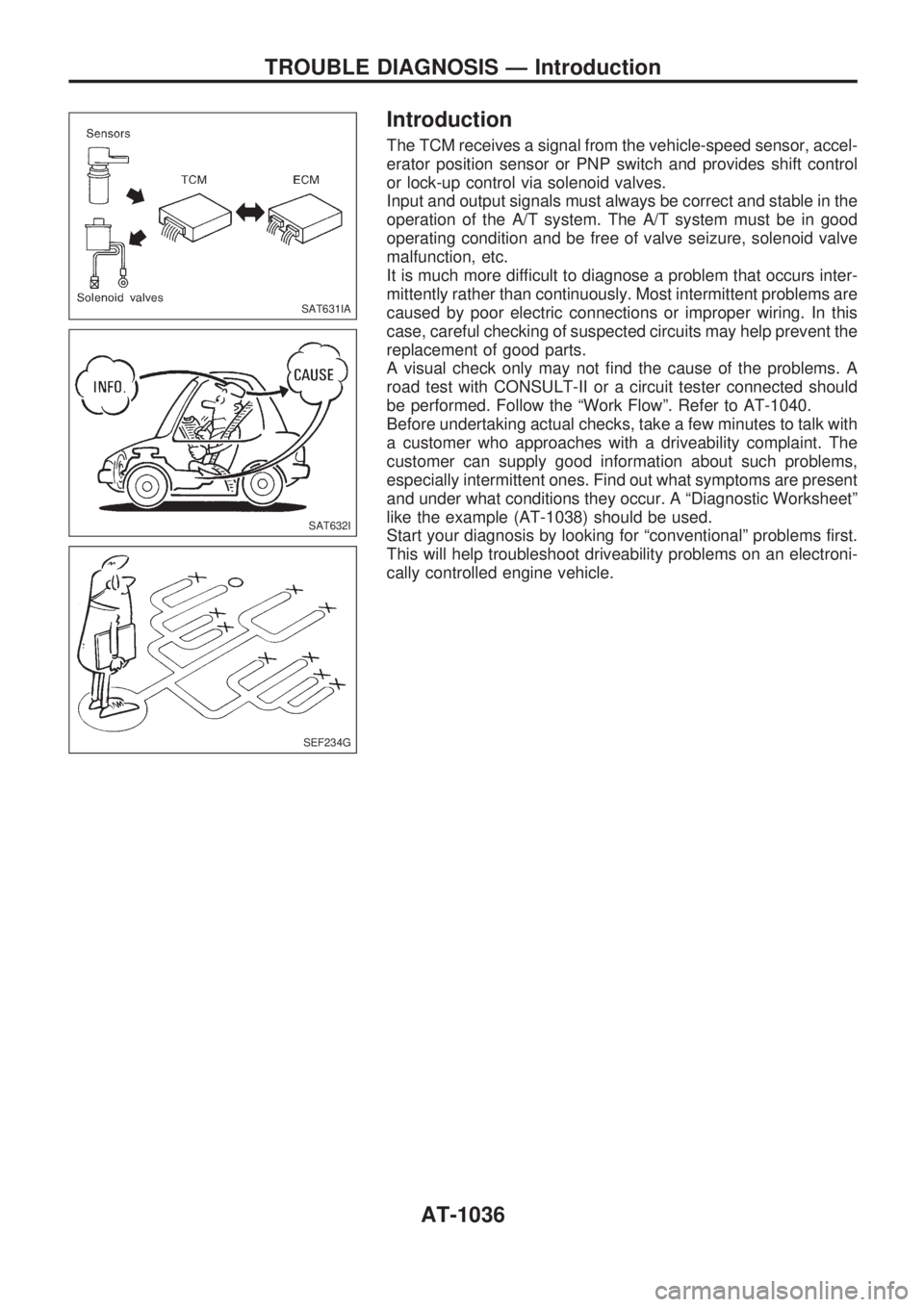
Introduction
The TCM receives a signal from the vehicle-speed sensor, accel-
erator position sensor or PNP switch and provides shift control
or lock-up control via solenoid valves.
Input and output signals must always be correct and stable in the
operation of the A/T system. The A/T system must be in good
operating condition and be free of valve seizure, solenoid valve
malfunction, etc.
It is much more difficult to diagnose a problem that occurs inter-
mittently rather than continuously. Most intermittent problems are
caused by poor electric connections or improper wiring. In this
case, careful checking of suspected circuits may help prevent the
replacement of good parts.
A visual check only may not find the cause of the problems. A
road test with CONSULT-II or a circuit tester connected should
be performed. Follow the ªWork Flowº. Refer to AT-1040.
Before undertaking actual checks, take a few minutes to talk with
a customer who approaches with a driveability complaint. The
customer can supply good information about such problems,
especially intermittent ones. Find out what symptoms are present
and under what conditions they occur. A ªDiagnostic Worksheetº
like the example (AT-1038) should be used.
Start your diagnosis by looking for ªconventionalº problems first.
This will help troubleshoot driveability problems on an electroni-
cally controlled engine vehicle.
SAT631IA
SAT632I
SEF234G
TROUBLE DIAGNOSIS Ð Introduction
AT-1036
Page 46 of 1033
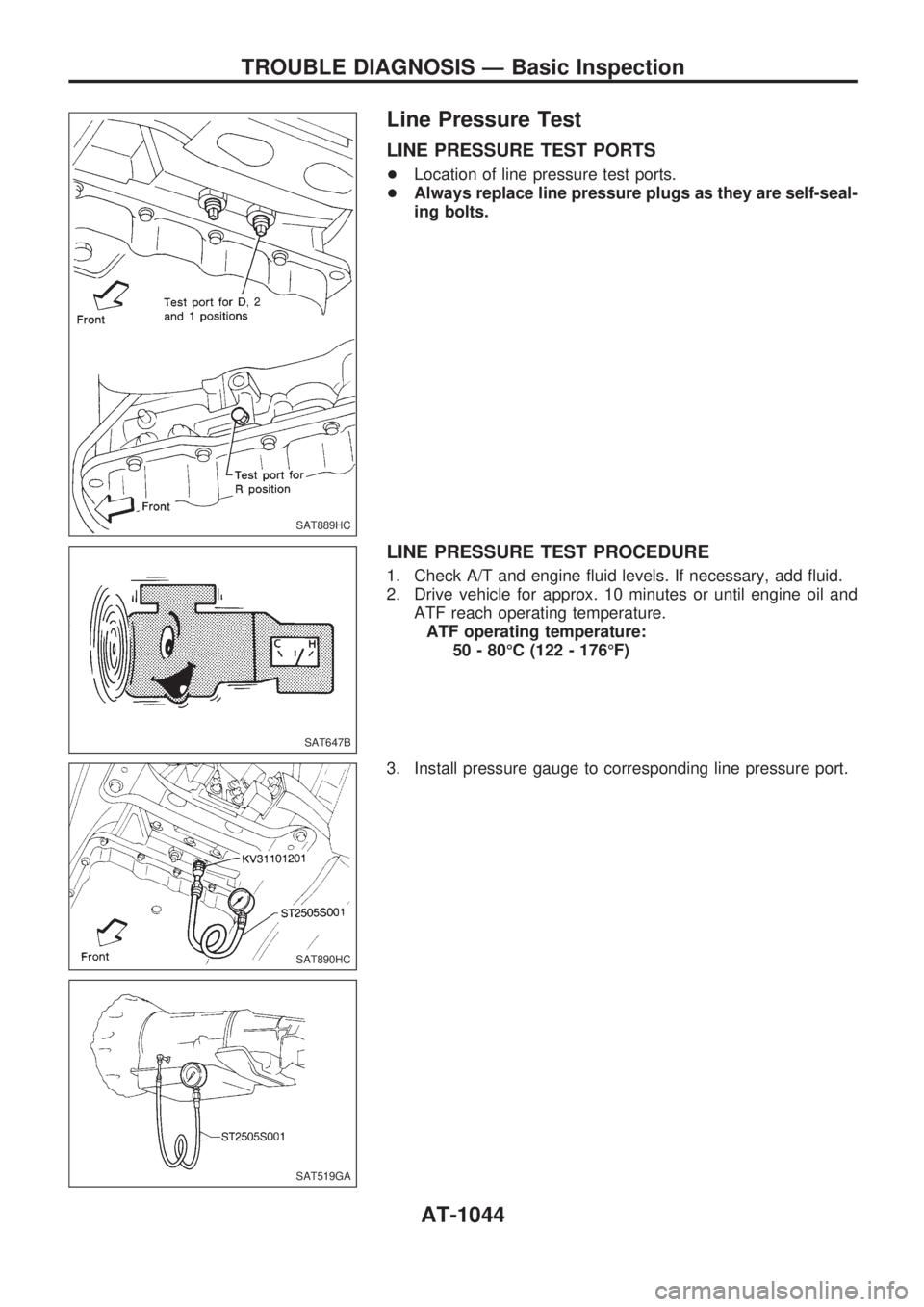
Line Pressure Test
LINE PRESSURE TEST PORTS
+Location of line pressure test ports.
+Always replace line pressure plugs as they are self-seal-
ing bolts.
LINE PRESSURE TEST PROCEDURE
1. Check A/T and engine fluid levels. If necessary, add fluid.
2. Drive vehicle for approx. 10 minutes or until engine oil and
ATF reach operating temperature.
ATF operating temperature:
50 - 80ÉC (122 - 176ÉF)
3. Install pressure gauge to corresponding line pressure port.
SAT889HC
SAT647B
SAT890HC
SAT519GA
TROUBLE DIAGNOSIS Ð Basic Inspection
AT-1044
Page 64 of 1033

Terminal
No.Wire color Item ConditionJudgement
standard (Approx.)
20 L/BOverrun clutch
solenoid valve
When overrun clutch solenoid
valve operates.Battery voltage
When overrun clutch solenoid
valve does not operate.0V
21 Ð Ð
ÐÐ
22 GYOverdrive control
switchWhen setting overdrive control
switch in ªONº positionBattery voltage
When setting overdrive control
switch in ªOFFº position0V
23 Ð Ð Ð Ð
24 Ð Ð Ð Ð Ð
25 B Ground
ÐÐ
26 GPNP ª1º position
switchWhen setting selector lever to ª1º
position.Battery voltage
When setting selector lever to
other positions.0V
27 G/WPNP ª2º position
switchWhen setting selector lever to ª2º
position.Battery voltage
When setting selector lever to
other positions.0V
28 R/YPower source
(Back-up)
or
When turning ignition switch to
ªOFFº.Battery voltage
When turning ignition switch to
ªONº.Battery voltage
29 WRevolution sensor
(Measure in AC
range)
When vehicle cruises at 30 km/h
(19 MPH).1V or more
Voltage rises gradu-
ally in response to
vehicle speed.
When vehicle parks. 0V
30*1 Y/G (RX)
ÐÐ
31*1 Y/R (TX) Ð Ð
32 G/RAccelerator posi-
tion sensor
(Power source)Turn ignition switch to ªONº. 4.5 - 5.5V
33 Ð Ð Turn ignition switch to ªOFFº. 0V
*1: These terminals are connected to the data link connector.
TROUBLE DIAGNOSIS Ð General Description
TCM Terminals and Reference Value (Cont'd)
AT-1062
Page 65 of 1033
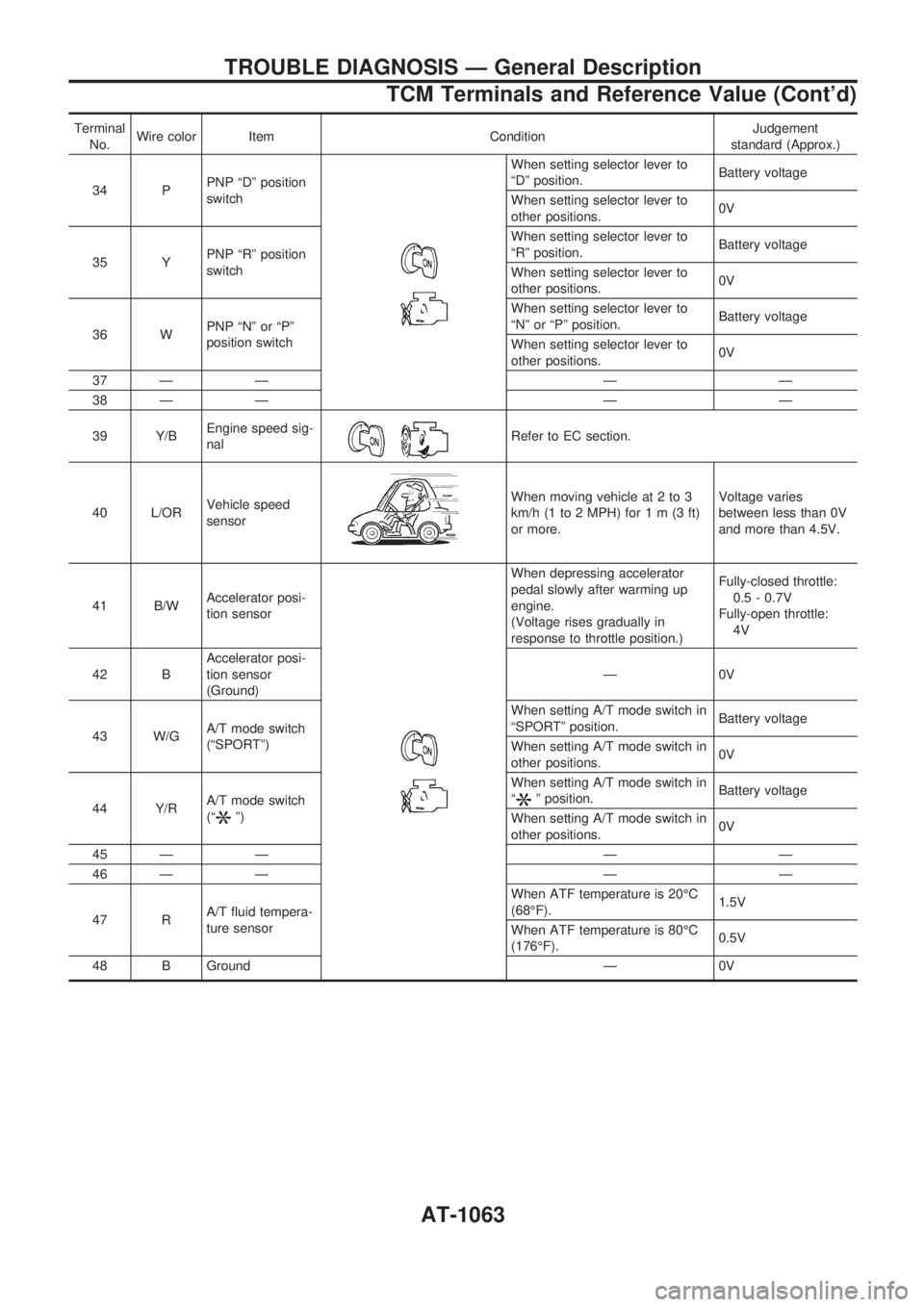
Terminal
No.Wire color Item ConditionJudgement
standard (Approx.)
34 PPNP ªDº position
switch
When setting selector lever to
ªDº position.Battery voltage
When setting selector lever to
other positions.0V
35 YPNP ªRº position
switchWhen setting selector lever to
ªRº position.Battery voltage
When setting selector lever to
other positions.0V
36 WPNP ªNº or ªPº
position switchWhen setting selector lever to
ªNº or ªPº position.Battery voltage
When setting selector lever to
other positions.0V
37 Ð Ð Ð Ð
38 Ð Ð Ð Ð
39 Y/BEngine speed sig-
nal
Refer to EC section.
40 L/ORVehicle speed
sensor
When moving vehicle at 2 to 3
km/h (1 to 2 MPH) for1m(3ft)
or more.Voltage varies
between less than 0V
and more than 4.5V.
41 B/WAccelerator posi-
tion sensor
When depressing accelerator
pedal slowly after warming up
engine.
(Voltage rises gradually in
response to throttle position.)Fully-closed throttle:
0.5 - 0.7V
Fully-open throttle:
4V
42 BAccelerator posi-
tion sensor
(Ground)Ð0V
43 W/GA/T mode switch
(ªSPORTº)When setting A/T mode switch in
ªSPORTº position.Battery voltage
When setting A/T mode switch in
other positions.0V
44 Y/RA/T mode switch
(ª
º)When setting A/T mode switch in
ª
º position.Battery voltage
When setting A/T mode switch in
other positions.0V
45 Ð Ð Ð Ð
46 Ð Ð Ð Ð
47 RA/T fluid tempera-
ture sensorWhen ATF temperature is 20ÉC
(68ÉF).1.5V
When ATF temperature is 80ÉC
(176ÉF).0.5V
48 B Ground Ð 0V
TROUBLE DIAGNOSIS Ð General Description
TCM Terminals and Reference Value (Cont'd)
AT-1063
Page 67 of 1033
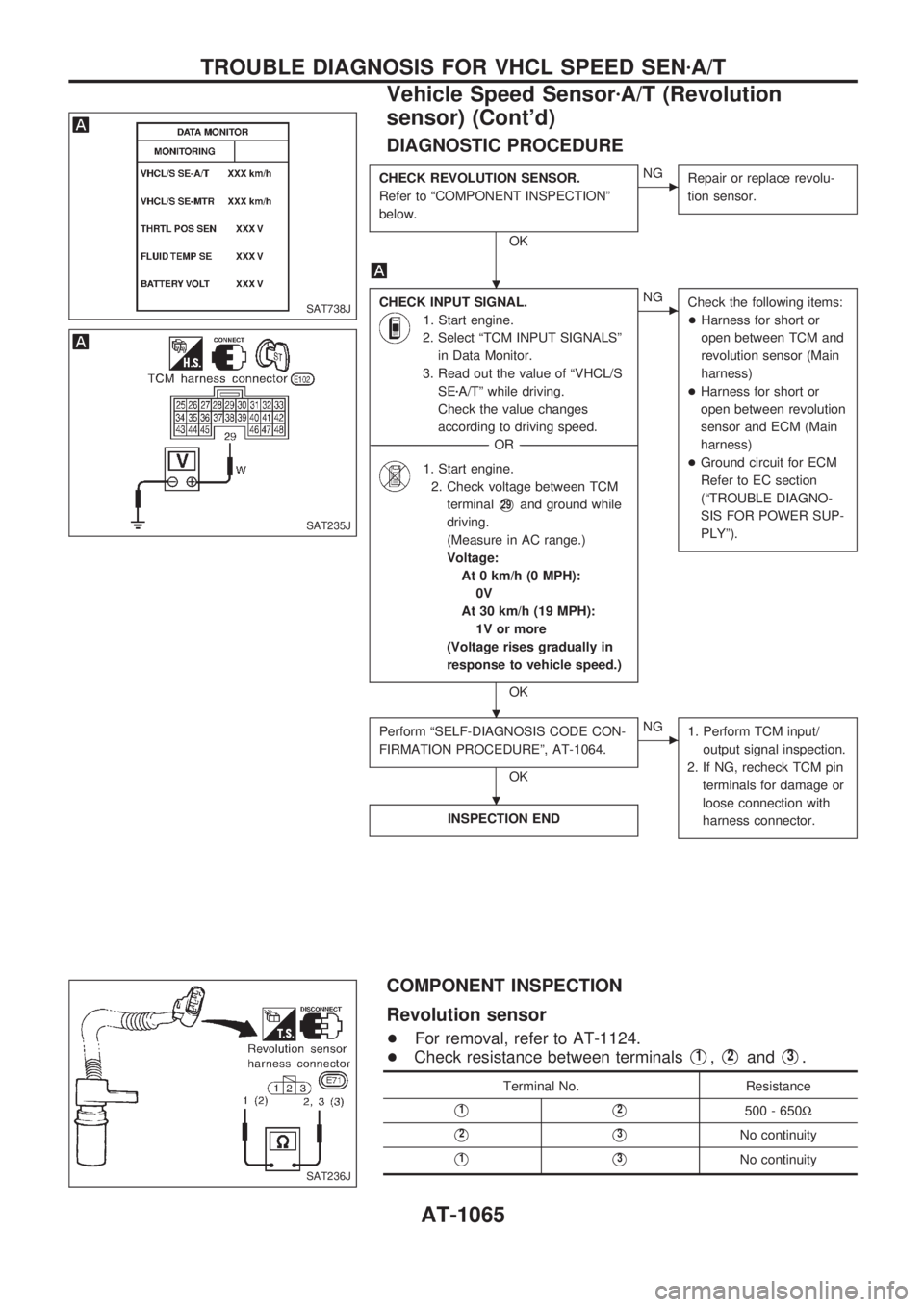
DIAGNOSTIC PROCEDURE
CHECK REVOLUTION SENSOR.
Refer to ªCOMPONENT INSPECTIONº
below.
OK
cNG
Repair or replace revolu-
tion sensor.
CHECK INPUT SIGNAL.
1. Start engine.
2. Select ªTCM INPUT SIGNALSº
in Data Monitor.
3. Read out the value of ªVHCL/S
SEzA/Tº while driving.
Check the value changes
according to driving speed.
------------------------------------------------------------------------------------------------------------------------------------OR------------------------------------------------------------------------------------------------------------------------------------
1. Start engine.
2. Check voltage between TCM
terminal
V29and ground while
driving.
(Measure in AC range.)
Voltage:
At 0 km/h (0 MPH):
0V
At 30 km/h (19 MPH):
1V or more
(Voltage rises gradually in
response to vehicle speed.)
OK
cNG
Check the following items:
+Harness for short or
open between TCM and
revolution sensor (Main
harness)
+Harness for short or
open between revolution
sensor and ECM (Main
harness)
+Ground circuit for ECM
Refer to EC section
(ªTROUBLE DIAGNO-
SIS FOR POWER SUP-
PLYº).
Perform ªSELF-DIAGNOSIS CODE CON-
FIRMATION PROCEDUREº, AT-1064.
OK
cNG
1. Perform TCM input/
output signal inspection.
2. If NG, recheck TCM pin
terminals for damage or
loose connection with
harness connector.
INSPECTION END
COMPONENT INSPECTION
Revolution sensor
+For removal, refer to AT-1124.
+Check resistance between terminals
V1,V2andV3.
Terminal No. Resistance
V1V2500 - 650W
V2V3No continuity
V1V3No continuity
SAT738J
SAT235J
SAT236J
.
.
.
TROUBLE DIAGNOSIS FOR VHCL SPEED SENzA/T
Vehicle Speed SensorzA/T (Revolution
sensor) (Cont'd)
AT-1065
Page 71 of 1033
![NISSAN PATROL 2000 Electronic Repair Manual DIAGNOSTIC PROCEDURE
Perform diagnostic test mode II (self-
diagnostic results) for engine control.
Refer to EC section [ªMalfunction Indica-
tor (MI)º, ªON BOARD DIAGNOSTIC
SYSTEM DESCRIPTIONº].
NISSAN PATROL 2000 Electronic Repair Manual DIAGNOSTIC PROCEDURE
Perform diagnostic test mode II (self-
diagnostic results) for engine control.
Refer to EC section [ªMalfunction Indica-
tor (MI)º, ªON BOARD DIAGNOSTIC
SYSTEM DESCRIPTIONº].](/manual-img/5/57367/w960_57367-70.png)
DIAGNOSTIC PROCEDURE
Perform diagnostic test mode II (self-
diagnostic results) for engine control.
Refer to EC section [ªMalfunction Indica-
tor (MI)º, ªON BOARD DIAGNOSTIC
SYSTEM DESCRIPTIONº].
OK
cNG
Check accelerator position
sensor circuit for engine
control. Refer to EC sec-
tion [ªTROUBLE DIAGNO-
SIS FOR ªTHRTL
(ACCEL) POSI SENº
(DTC 43)].
CHECK INPUT SIGNAL.
1. Turn ignition switch to ªONº
position.
(Do not start engine.)
2. Select ªTCM INPUT SIGNALSº
in Data Monitor.
3. Read out the value of ªTHRTL
POS SENº.
Voltage:
Fully-closed throttle:
Approximately 0.5V
Fully-open throttle:
Approximately 4V
------------------------------------------------------------------------------------------------------------------------------------OR------------------------------------------------------------------------------------------------------------------------------------
1. Turn ignition switch to ªONº
position. (Do not start engine.)
2. Check voltage between TCM
terminals
V41andV42while
accelerator pedal is depressed
slowly.
Voltage:
Fully-closed throttle valve:
Approximately 0.5 - 0.7V
Fully-open throttle valve:
Approximately 4V
(Voltage rises gradually in
response to throttle position)
OK
cNG
Check harness for short or
open between ECM and
TCM regarding accelerator
position sensor circuit.
(Main harness)
CHECK ACCELERATOR POSITION
SWITCH.
Refer to ªCHECK ACCELERATOR POSI-
TION SWITCHº, AT-1091.
OK
cNG
Repair or replace dam-
aged parts.
Perform ªSELF-DIAGNOSIS CODE CON-
FIRMATION PROCEDUREº, AT-1068.
OK
cNG
1. Perform TCM input/
output signal inspection.
2. If NG, recheck TCM pin
terminals for damage or
loose connection with
harness connector.
INSPECTION END
SAT738J
SAT239J
.
.
.
.
TROUBLE DIAGNOSIS FOR THROTTLE POSI SEN
Accelerator Position Sensor (Cont'd)
AT-1069